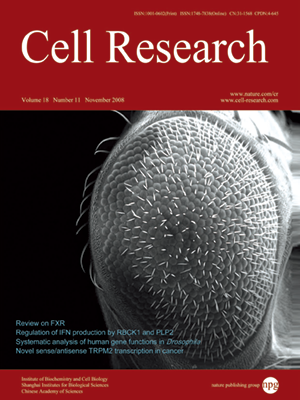
Volume 18, No 11, Nov 2008
ISSN: 1001-0602
EISSN: 1748-7838 2018
impact factor 17.848*
(Clarivate Analytics, 2019)
Volume 18 Issue 11, November 2008: 1114-1127
ORIGINAL ARTICLES
A large-scale functional approach to uncover human genes and pathways in Drosophila
Rong Xu1, Kejing Deng1, Yi Zhu1, Yue Wu1, Jing Ren1, Min Wan2, Shouyuan Zhao1, Xiaohui Wu1, Min Han1,2, Yuan Zhuang1,3 and Tian Xu1,4
1Institute of Developmental Biology and Molecular Medicine and School of Life Science, Fudan University, Shanghai 200433, China
2Howard Hughes Medical Institute and Department of MCDB, University of Colorado, Boulder, CO 80309-0347, USA
3Department of Immunology, Duke University Medical Center, Durham, NC 27708, USA
41Howard Hughes Medical Institute and Department of Genetics, Yale University School of Medicine, 295 Congress Avenue, BCMM236, New Haven, CT 06536, USA
Correspondence: Kejing Deng, Tian Xu,(dengkj@fudan.edu.cn; tian.xu@yale.edu)
We demonstrate the feasibility of performing a systematic screen for human gene functions in Drosophila by assaying for their ability to induce overexpression phenotypes. Over 1 500 transgenic fly lines corresponding to 236 human genes have been established. In all, 51 lines are capable of eliciting a phenotype suggesting that the human genes are functional. These heterologous genes are functionally relevant as we have found a similar mutant phenotype caused either by a dominant negative mutant form of the human ribosomal protein L8 gene or by RNAi downregulation of the Drosophila RPL8. Significantly, the Drosophila RPL8 mutant can be rescued by wild-type human RPL8. We also provide genetic evidence that Drosophila RPL8 is a new member of the insulin signaling pathway. In summary, the functions of many human genes appear to be highly conserved, and the ability to identify them in Drosophila represents a powerful genetic tool for large-scale analysis of human transcripts in vivo.
Cell Research (2008) 18:1114-1127. doi: 10.1038/cr.2008.295; published online 28 October 2008
FULL TEXT | PDF
Browse 2002


